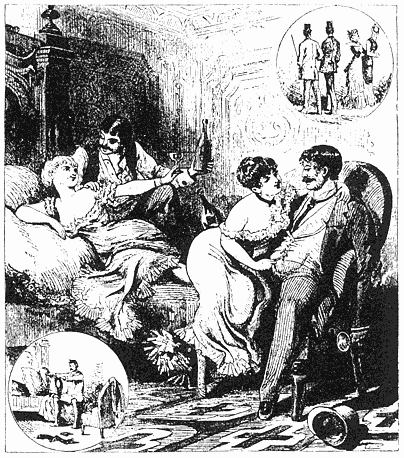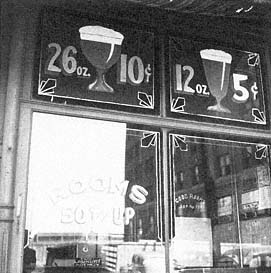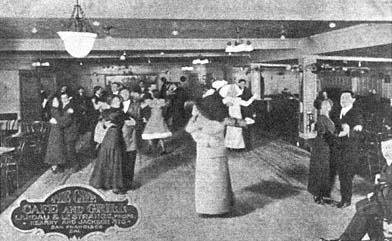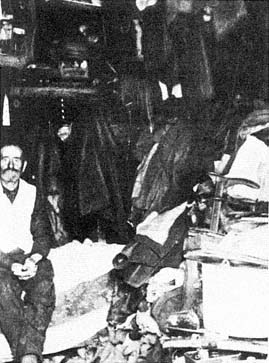Hazards for the Individual
The lives of single people in hotels invoked repeated reform critiques. The youth culture and recreation zones in rooming house districts were causes of alarm. Yet overarching all was the lack of parental and neighborly supervision of the sort that critics assumed to exist in traditional small towns. Ironically, some hotel residents felt too closely watched in hotels; they complained about feeling "very much in the public eye, . . . living in public, eating in public, and all but sleeping in public." A writer who had lived in a fifty-four-room hotel for thirteen years said she overheard servants having frequent conversations about guests; furthermore, she said, each guest was "carefully watched by certain 'old tabbies'" who lived there.[42] Yet, in the eyes of late Victorian and Progressive Era observers, this hotel surveillance packed too little social pressure to counter the environment's sexual temptations or its professional crime.
Sexual Immorality and Improper Recreation
According to mainstream reform views, the potentials for personal immorality—frequent sexual liaisons outside marriage—loomed much larger for people living in hotels than for people in suburban houses. The reasons seemed clear: in hotels, members of the opposite sex lived on the same hallways, had the right to visit one another's rooms, and could come and go quietly. New people moved in weekly or monthly. Sexual immorality, in fact, was the problem that prompted the settlement house resident, Albert Wolfe, to publish his exhaustive 1906 study, The Lodging House Problem in Boston . He decried many evils of rooming house life but identified sexual immorality as the "darkest aspect." Reformers in many cities described unmarried couples living together as major evidence of a "general loosening of moral texture."[43] Each time a landlady said, "What my tenants do is their own business as long as they pay their rent on time," she had substituted commerce for traditional social controls. Rooming houses, others said, had lost the "personal element in life."[44]
Along with their focus on sexual offenders, reformers also focused on the mixture of wayward souls with other, impressionable people. Hotels and rooming houses, said Wolfe, exuded an "atmosphere of moral laxity" that was dangerous for virtuous country people who had been thrown into the deep water of city life. "Consciously or unconsciously, the influence of imitation will be at work," he wrote. "If we stay in Rome long enough, we do as the Romans do."[45] Matrons in San Francisco concurred with Wolfe. The housing danger for a single girl in the 1920s was no longer the white slaver but the gradual breaking down of spiritual and moral standards as a result of improper surroundings and companionship. The cheapest residential hotel rooms, the matrons added, caused the most overcrowding, worst sanitation, and greatest "moral strain."[46] The high incidence of venereal disease among roomers and the number of abortion clinics in rooming house neighborhoods underscored concerns about sex, as did the belief that the temporary sexual liaison was "one avenue through which the prostitute class, both of men and women," was recruited.[47]
Prostitutes did live in some hotels, and they could both learn and practice their trade there (fig. 7.9). The shadier rooming houses associated with beer gardens and commercial amusement gardens were almost sure to be places of assignation. In 1915, housing inspectors in Stockton, California, wove their concerns about prostitution into a survey of rooming houses located over saloons:
Women openly solicit in booths in the saloons and take men to the rooms upstairs. In one house the inspector observed that every man accompanied by a woman was asked whether the room was desired for "only a little while or for the night."[48]
In other cities, larger hotels also came in for criticism because prostitutes mixed too easily with tenants. Reformers reiterated that in hotels, both men and women lived next door to "fearful possibilities."[49]
Since people of the same sex routinely shared a hotel room (and sometimes shared a bed) without comment, homosexual couples blended without notice into the upper ranks of hotel life. But in cheap lodging houses and missions, where visual and acoustical privacy was difficult, social investigators made careful note of homosexual solicitation and activity. The sociologist of hobo life, Nels Anderson, reported that homosexual practices among male migrant laborers were fairly

Figure 7.9
Prostitute thieves plying their trade with the help of an elegant hotel room.
A cautionary view from the National Police Gazette , 1879.
common. Although he said they were not more frequent than in other all-male situations—prisons, the army, or the navy—these relationships concerned the parents of adolescent boys doing migrant work.[50] Such realities added to the sexual taint of hotel life.
More prevalent than sexual immorality were the perceived dangers of drinking, dancing, café life, and cheap amusements. Together they created another side of the "bright light district" and rooming house youth culture that affronted reformers (fig. 7.10).[51] Similar problems, most vivid in the elite hotels, were associated with all types of hostelries. Elbert Hubbard, author of the popular A Message to Garcia and an enthusiastic booster of Craftsman-style bungalows, characterized the residents of expensive hotels as "a gilded, gabby gang of newly gotten rich, or the offspring of such." The flashy hotels were places "where the vampire finds her hunting-ground, and the riot of the senses is complete; where flunkies flunky without ceasing, and the parasite is at

Figure 7.10
Signs of dangerous commercial and residential
mixture, 1936. This Kansas City drovers' hotel
advertises housing and beer at the same location.
home."[52] The Saturday Evening Post tersely called hotel life "the time killer industry." Chicago social workers acknowledged surprise at encountering families that seemed to like living in furnished rooms and rooming houses because they desired "the excitement that can be found in the rooming-house neighborhoods."[53]
Temperance crusaders aimed their hostility at hotel operators as well as at saloon keepers. The housing expert Carol Aronovici, in a study of cheap lodging houses in St. Paul in 1917, took pains to photograph empty liquor bottles in the rooms. During Prohibition, some hotels engaged directly in bootlegging; at better hostelries, the bellmen often sold or gave telephone numbers for obtaining bootleg liquor. In 1921, the highly publicized death of a drunken woman during a party given by Roscoe (Fatty) Arbuckle in San Francisco's St. Francis Hotel gave the term "Arbuckle party" to any wild hotel room celebration.[54]
The volatile combination of fast and close dancing, alcohol, and the absence of chaperones spelled trouble to reform-minded people wherever it occurred—in a grand hotel or in a cheap dive. In 1883, a Methodist church in San Francisco listed dancing twice among its list of sinful city amusements. Indeed, many of the cafés frequented by hotel residents also featured daily dancing and introductions of men and women by café employees (fig. 7.11).[55] Some palace hotels scheduled weekly and then daily tea dances. In 1917, a concerned citizen published a newspaper article entitled "Afternoon Teas First Step Toward

Figure 7.11
Postcard view of the Cave Cafe and Grill, near San Francisco's rebuilt
Barbary Coast, ca. 1920. The back of the postcard promised
"something doing all the time"—exactly what worried
reformers about unchaperoned social life.
Depths; Evolution of Good Girls to 'Flappers' of the Bright Lights Is Subtle Transition."[56]
Pathological Proximities and Isolation
Another, less visible hazard of hotel life, according to critics, was its potential for leading to a life of crime. Reformers saw this risk particularly in cheap lodging houses, where young people might mix with the most hardened criminals. The chief of New York's secret police branded the laborers' hotels of the Bowery as "nurseries of crime." He claimed that the peril peaked when a young man was nearly broke and he checked into a 15-cent lodging house:
[The young man is then] ready for the tempter whom he finds waiting for him there, reinforced by the contingent of ex-convicts returning from the prisons after having served out their sentences for robbery or theft. . . . In nine cases out of ten, he turns out a thief, or a burglar, if indeed, he does not sooner or later become a murderer.[57]
To his credit, the police chief saw lack of work as the root cause of this progression, but this was lost in related discussions. In a conversation with Riis, a New York police court justice vowed that the 10-cent lodging houses more than counterbalanced "the good done by the free reading room, lectures, and all other agencies of reform." He continued that "such lodging houses have caused more destitution, more beggary and crime than any other agency" he knew.[58] In the twentieth century, Los Angeles police routinely searched for law offenders in the cheap hotels

Figure 7.12
Suspicious isolation and improper material life.
The caption for this photograph in the 1919
report of California's Commission on Immigration
and Housing read, "Is the housing problem
merely a problem of houses ? Can we expect
this man to be 100 percent American?"
and rooming houses near the railroad station. Raymond Chandler's detective character, Philip Marlowe, repeatedly visited hotels "whose clerks were 'half watchdog and half pander' and where nobody except Smith or Jones signed the register."[59]
A different but also negative side to the illicit adjacency of hotel life was the friendless life also possible there: the painful isolation for those who did not want to be alone, or those who were pathologically withdrawing from human company (fig. 7.12). According to one hotel resident, a hotel filled with people having fun could be "the most lonely place in the world." Rooming house residents with no friends in the area could write poignantly about the "cramped and awful loneliness of a hall bedroom." Young people who did not frequent dance halls or lively cafés but passed them frequently were constantly reminded of their own solitude.[60]
Zorbaugh—whose personal loneliness during his Chicago fieldwork added to his sharp distaste for hotel life—said that hotels carried individualization "to the extreme of personal and social disorganization." Rooming houses "were a world of atomized individuals, or spiritual nomads."[61] As proof, Zorbaugh presented the following statement
of a young rooming house woman who had moved to Chicago from Emporia, Kansas, for fervent but futile study as a violinist:
One gets to know few people in a rooming-house, for there are constant comings and goings, and there is little chance to get acquainted if one wished. . . . There were occasional little dramas—as when a baby was found in the alley, and when the woman in the "third floor back" took poison after a quarrel with her husband . . . when the halls and the bathrooms were the scenes of a few minutes' hurried and curious gossip. But the next day these same people would hurry past each other on the stairs without speaking.[62]
Whether or not single-room housing caused such isolation, lonesomeness was part of the territory.
Frequently published reports of suicides kept vivid the public image of pathological isolation in hotels and rooming houses. One hotel manager explained that after gaslights and gas heaters became standard equipment, suicide in hotel rooms was more common; suicide with gas was easier than using a gun or a razor blade.[63] Dozens of novelists set suicides in single-room housing. Hurstwood, the erstwhile husband in Dreiser's Sister Carrie , lives his last months in cheap rooming houses where he "toils up" the inevitable "creaky stairs." In a tiny room with gas jets "almost prearranged" for what he intends, he eventually kills himself with a final antisocial phrase, "What's the use?"[64]